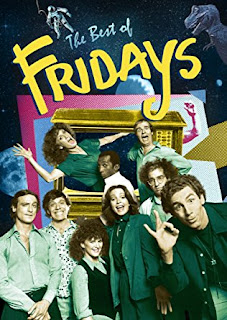Fridays was a
late-night sketch comedy program that aired in the early 1980s. Admittedly a
Saturday Night Live rip-off, at least at
first, this show actually had a much different approach to comedy in many ways.
It gave Michael Richards and Larry David their start (they’d, of course, work
together later on
Seinfeld), and
launched the careers of several young writers, including Larry Charles. That
right there makes the show worth viewing, but the fact is that
Fridays had some of the funniest and
most ambitious sketches of any show I’ve ever seen.
The Best Of Fridays,
a collection of sixteen episodes (and lots of special features), is worth
owning, if even just for The Ronny Horror
Show sketch and for the Andy Kaufman episode. But there are also some great
musical guests including Tom Petty And The Heartbreakers, The Stray Cats, The
Cars, Pat Benatar, and The Clash (The Clash do four songs, including “The Guns
Of Brixton” and “Train In Vain”). Of course, you do have to sit through two
songs by KISS, a band I never found the least bit interesting. But no matter.
There are also two short films by Michael Nesmith (yes, of
The Monkees). And there is a great cast, including Mark Blankfield, Maryedith
Burrell, Melanie Chartoff, Larry David, Darrow Igus, Brandis Kemp, Bruce
Mahler, Michael Richards and John Roarke (who is fantastic as Ronald Reagan),
with appearances by Rich Hall. The show had guest stars for some episodes, but
not all. Of the episodes included here, Karen Allen, William Shatner and Andy
Kaufman are the stand-out hosts.
As I said, the show was admittedly similar to Saturday Night Live, and so the cast and
writers addressed the similarities in the very first sketch of the first
episode. Co-creators John Moffitt and Bill Lee tell the cast that they might be
compared to Saturday Night Live. Then
we see the cast, all dressed as popular SNL
characters (bee, Conehead, etc.), as a message scrolls up the screen. What a
perfect way to get that out of the way.
Fridays, like Saturday Night Live, did a parody of a
news program, here called “Friday Edition,” anchored by Melanie Chartoff. (I’m
sure I wasn’t the only kid to have a crush on Melanie Chartoff. And Melanie, if
you happen to read this, Hi.) After the bastard Ronald Reagan was elected,
Melanie says: “Following this week’s
election, the presidency and the Senate now belong to conservatives. And one of
the contributing factors in their victory was the influence of fundamentalist
religious groups, particularly the Moral Majority led by evangelist Jerry
Falwell. Although some are concerned about the effect of these groups on the
political process, we on the Friday Edition feel that there is no cause for
undue alarm. This is not the first time that the church has injected itself
into politics. Why, just look at the Spanish Inquisition, the Salem witch
hunts, and the takeover of the Iranian government by fanatical Muslims. Now,
doesn’t that make you feel just a bit better?” Yes, I love her. In another
news segment, in a story about a senator who switched parties, she says that
the senator “said that he’d been dressing
as Republican in private for quite some time.”
The most famous sketch on Fridays was the one in which Andy Kaufman broke character and
refused to go on, saying that he felt stupid playing stoned. The sketch
featured three cast members at a restaurant with Andy Kaufman, and each of the
four was to get up and go to the bathroom to get stoned. When Andy returns to
the table, he brings the sketch to a halt. Michael Richards then gets up,
retrieves the cue cards, and plops them down on the table in front of Andy. And
from there it starts to get violent, and the show suddenly ends. (By the way,
at the beginning of the episode, the announcer screws up and says “Larry David”
over the photo of Melanie Chartoff, then corrects himself. Melanie misses the
chance for a joke when she introduces herself at the beginning of the news
segment; she should have said, “Good evening, I’m Larry David.”) The show continued the joke into the
following episode, with Billy Crystal asking if the Andy Kaufman sketch was
real, and then having his bodyguard tackle anyone who gets close to him. Andy
Kaufman later makes an appearance, reading a prepared explanation, but then
breaking again and saying he can’t do it, once again putting into question
whether it was planned or not.
It’s fairly daring stuff for a sketch comedy show. But my
absolute favorite sketch – probably my favorite sketch ever from any show – is The Ronny Horror Show. A parody of The Rocky Horror Picture Show, it places
Ronald Reagan in the Frank N Furter role, with the Transylvanians being
conservatives (I admit, I love their fur boas). Brad and Janet are on their way
to an anti-nuke rally, but stop in at the castle to use the phone. It really
follows the film, even beginning with the lips singing “Politicians Double
Dealers” in place of “Science Fiction Double Feature,” with the line, “It’s the eighties Ronny Reagan horror show.”
They went all out on this one. The props, the costumes, the makeup – everything
is exactly right. And it’s a musical, with several songs, and the songs are
really good and completely hilarious and biting. In the take on “The Time
Warp,” Riff Raff (George Bush Sr.) sings, “We
have seized control.” And then Ronald Reagan in the take on “Sweet
Transvestite,” sings, “I’m just an
arch-conservative, anti-intellectual chief executive from California.”
Brilliant, eh? And when Eddie comes out of the freezer, it’s Nixon on the
motorcycle, singing “Whatever happened to
Watergate?” When Ronny unwraps his creation, it turns out to be a black
militant, and this is when things get even more interesting. Reagan is flabbergasted,
saying this isn’t what he created. But Janet tells him, “He is your creation, born of your narrow-minded moralistic viewpoints.”
And the cast goes into another version of “Time Warp,” this time singing, “Let’s fight the system again,” as everyone
turns against Ronny. So yes, it has a positive ending. The sketch is seventeen
minutes long, and gets a well-deserved standing ovation from the audience.
There are lots of other sketches worth mentioning. In the
first episode there is the Muppet Hunt sketch, in which people are beating
Muppets in the sand, and then we go to Rodeo Drive, where coats made from
Muppets are sold. “They once warmed
hearts; they’ll now warm entire bodies.” That episode also has the
door-to-door prostitute sketch, which is totally hilarious. “May we come in and talk to you about our
product?” The Diner Of The Living
Dead is another highlight, with a couple entering a diner full of zombies,
and then ordering from the zombie menu: “I
think I’ll have the feet, hold the toenails.” The sketch combining Star Wars and Woody Allen is wonderful,
with Darth Vader trying to get Woody to give in to commercialism. The tooth
fairy sketch is brilliant, and not just because Melanie Chartoff is dressed
like a little girl, you perverts. Seriously, this is one of the best skits I’ve
seen. Michael Richards says, “Look,
there’s a TV critic, probably missing the whole point of this sketch.” And,
I can’t help it, the chicken skit from episode 15 had me in tears I was
laughing so hard.
One issue I do have with this box set is that I have to
wonder if we’re getting the full episodes. At the end of the episode with The Ronny Horror Show, Steve Forbert is
thanked. But we didn’t see him perform. The episodes vary widely in length,
some approximately 48 minutes, some only 38 minutes, and one only 32 minutes,
which adds to my feeling that we’re missing material.
Bonus Features
The entire fifth disc is all bonus material. The two main
features on this disc are “Actors’ Conversation” and “Writers’ Conversation,”
recently taped reunions, each just under an hour in length. The “Actors’
Conversation” features Melanie Chartoff, Bruce Mahler, Michael Richards, Darrow
Igus, Mark Blankfield, John Roarke and Brandis Kemp, with Steve Adams acting as
moderator. They tell lots of great anecdotes. The one about Ted Koppel is
pretty wild, as is the Shelley Winters anecdote. They talk about some of the
blunders, like when Michael Richards’ Darth Vader mask accidentally came off.
They talk about The Ronny Horror Show
and the Andy Kaufman episode. There is also a separate thirteen-minute
interview with cast member Maryedith Burrell, in which she talks about the Los
Angeles comedy scene at that time, and about the show and her fellow cast
members.
The “Writers’ Conversation” features Joe Shulkin, Larry
Charles, Tom Kramer, Bruce Kirschbaum, John Moffitt, Bruce Mahler and Elaine
Pope, with Steve Adams moderating. They talk about the competition among the
writers to get sketches on the air. One thing that was really interesting is that
there was a dress rehearsal Friday afternoons in front of a live audience, and
that audience’s reaction would determine how the show would go that night (in
front of a different audience). Understandably, they wonder just who these
losers were who had nothing better to do on a Friday early afternoon than watch
a rehearsal of a show. The bathroom issues are pretty funny. They also talk
about getting stoned with The Clash. But perhaps most interesting is that the
writers themselves were able to cast a script as they wrote it. That’s amazing.
Also in the bonus features is “The Andy Kaufman Incident
– What Really Happened?” John Moffitt explains how that sketch came about. We
also get more of the actors’ conversation, specifically about this. Steve Adams
asks which actors knew ahead of time. Michael Richards thought he was the only
actor in the sketch who knew ahead of time. But Melanie and Maryedith also
knew. We also get a little more of the interview with Maryedith Burrell.
The bonus material also includes “Friday On The News,” a
segment with Paul Moyer (Eyewitness L.A.)
which takes a look at the staff writers of the show and discusses the
comparisons with Saturday Night Live.
There is also a photo gallery.
The Best Of Fridays
is scheduled to be released on August 6, 2013 through Shout! Factory.
















